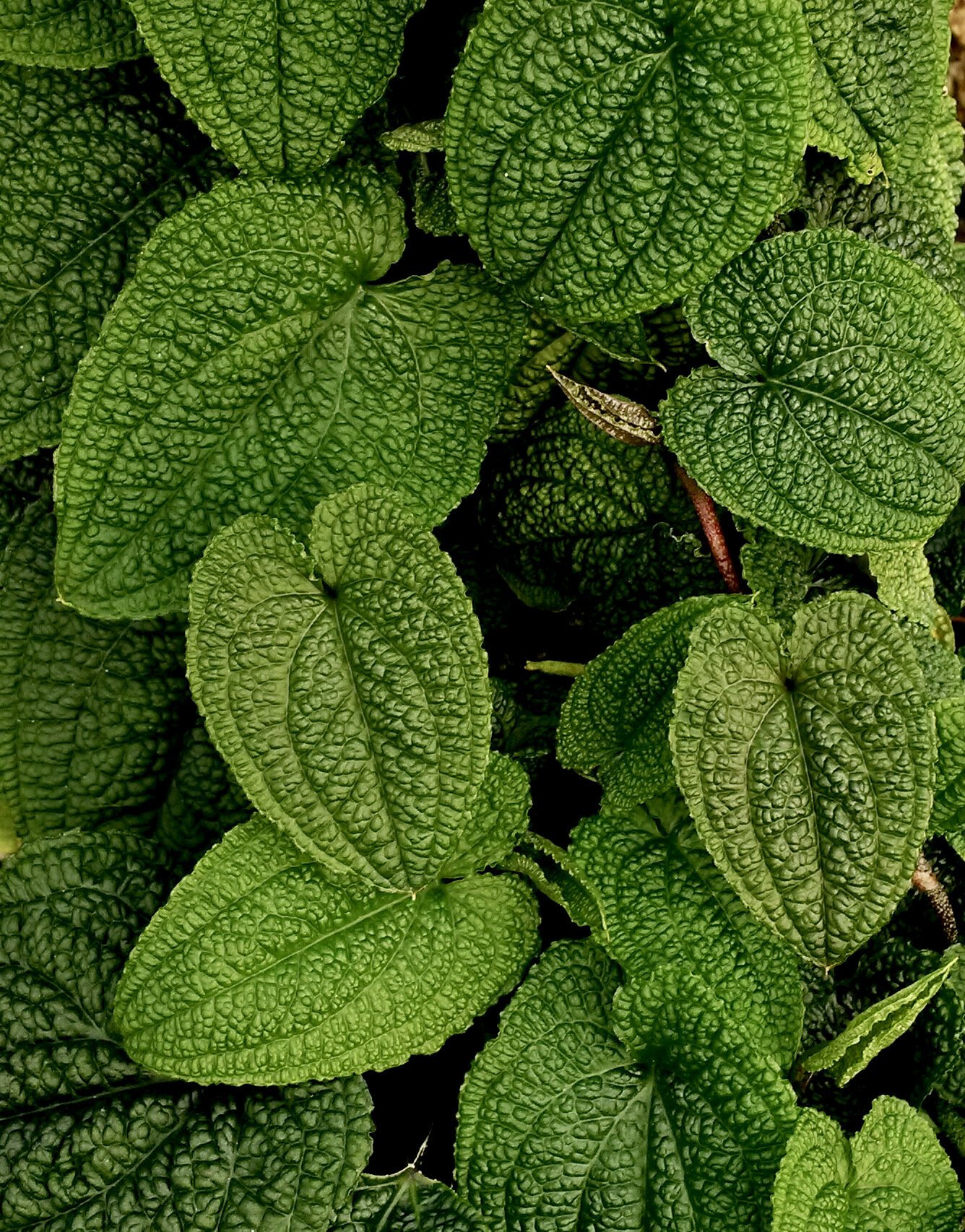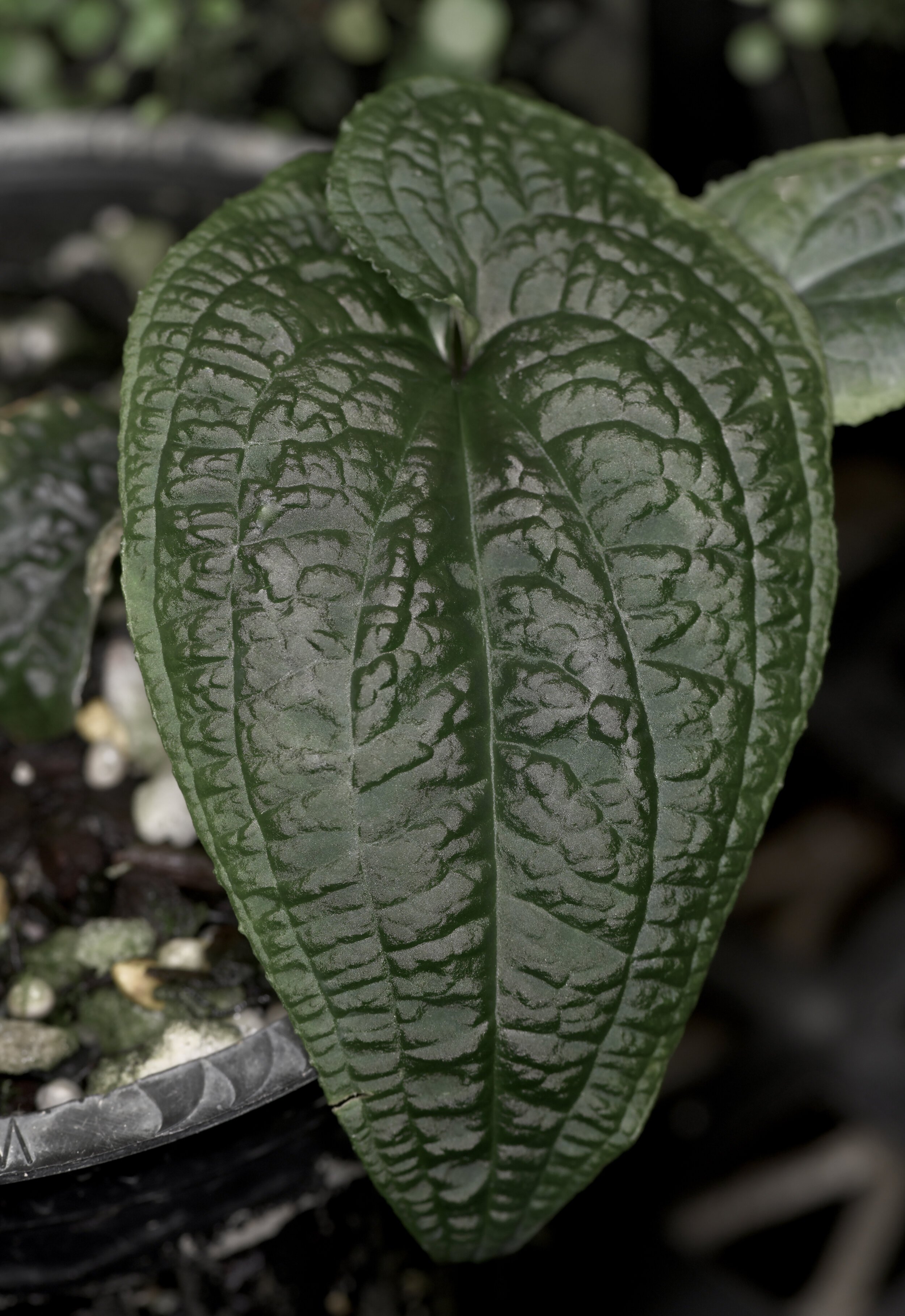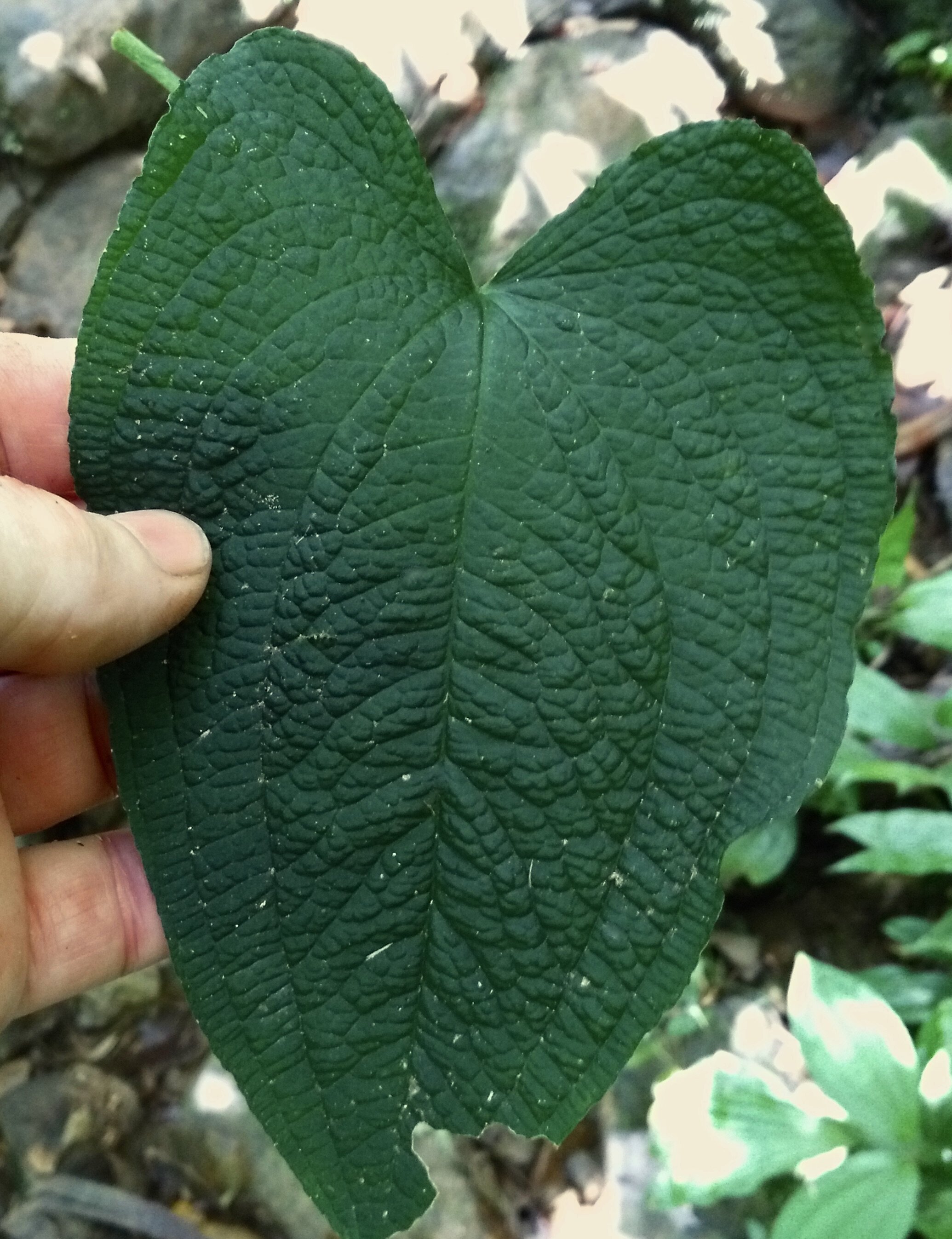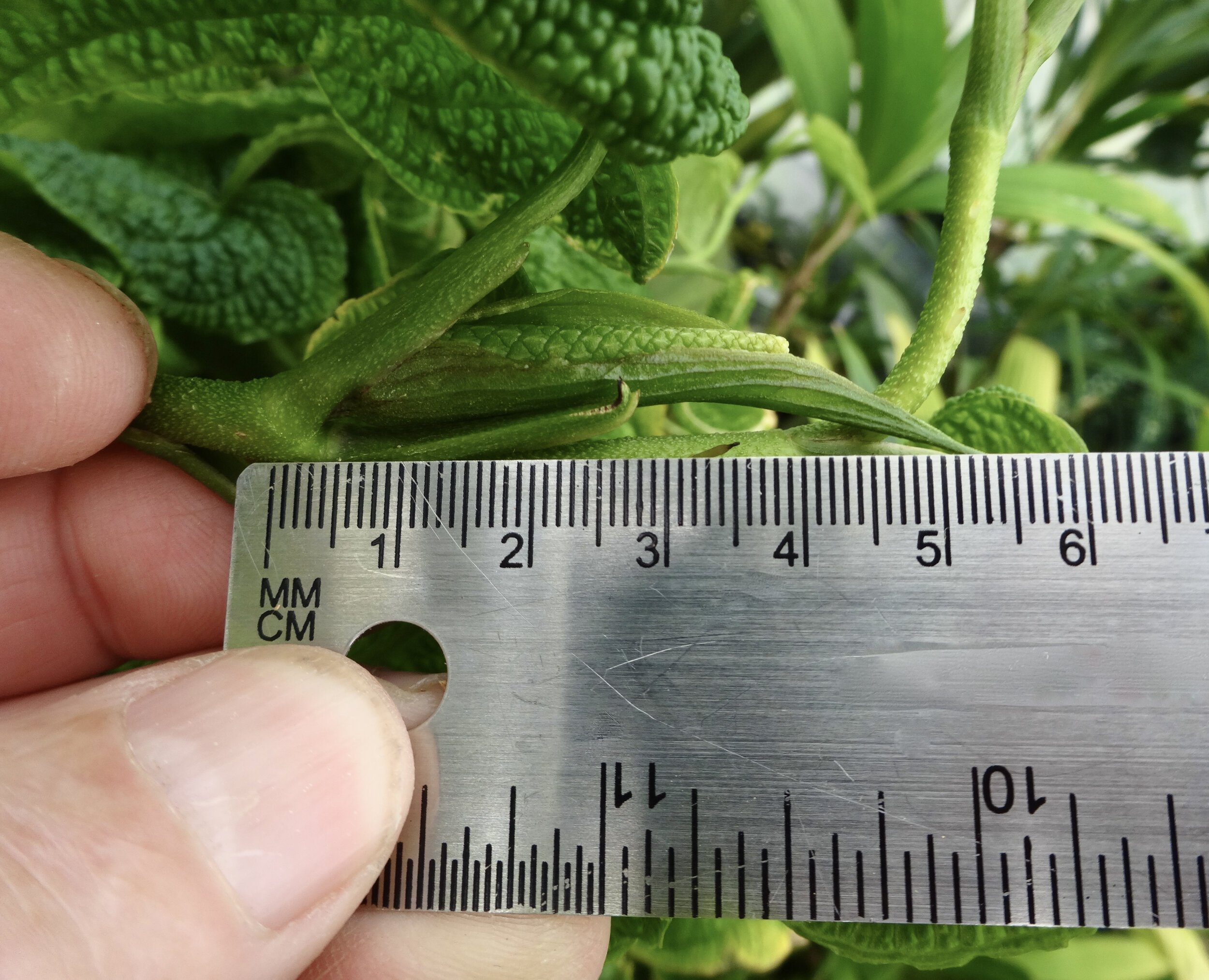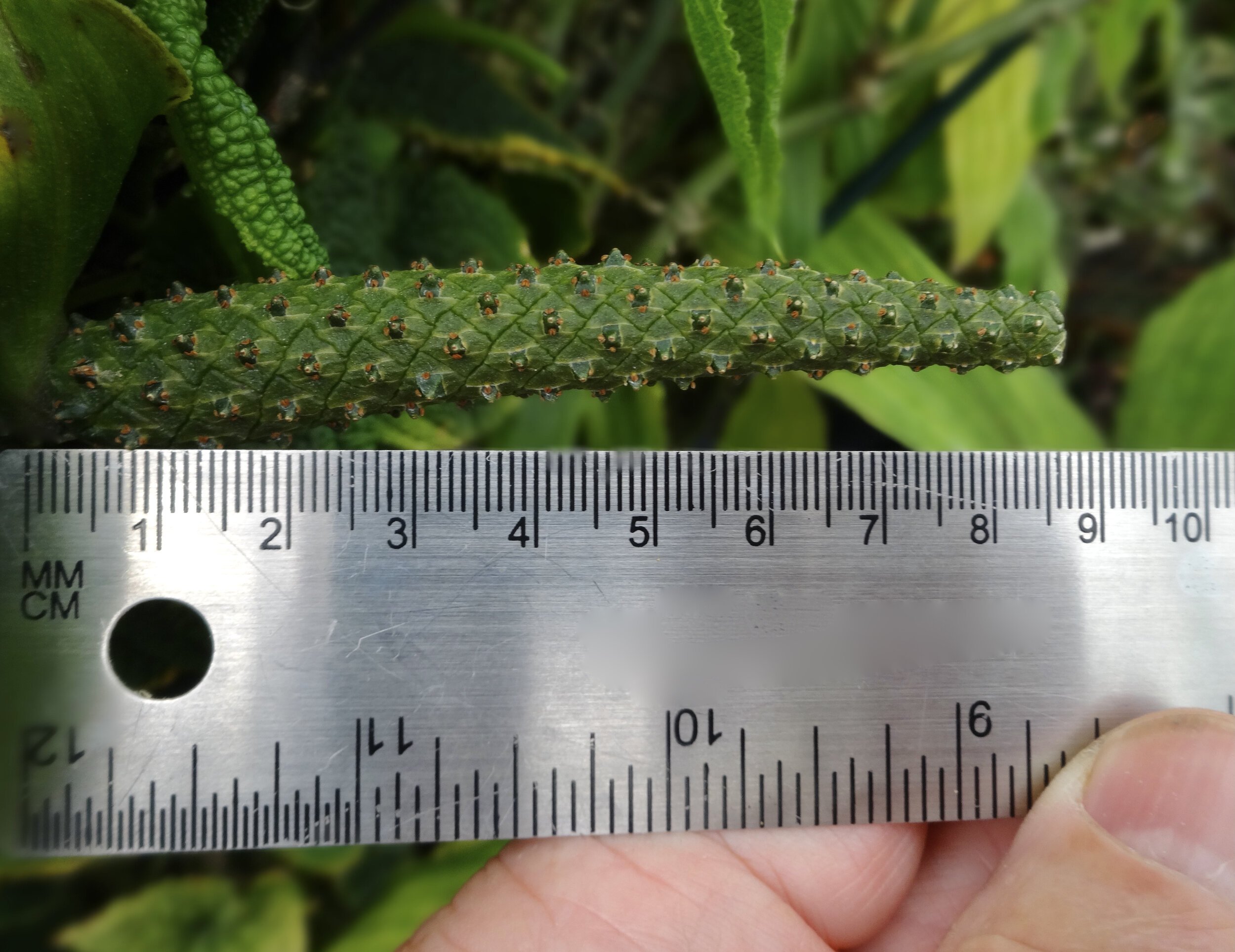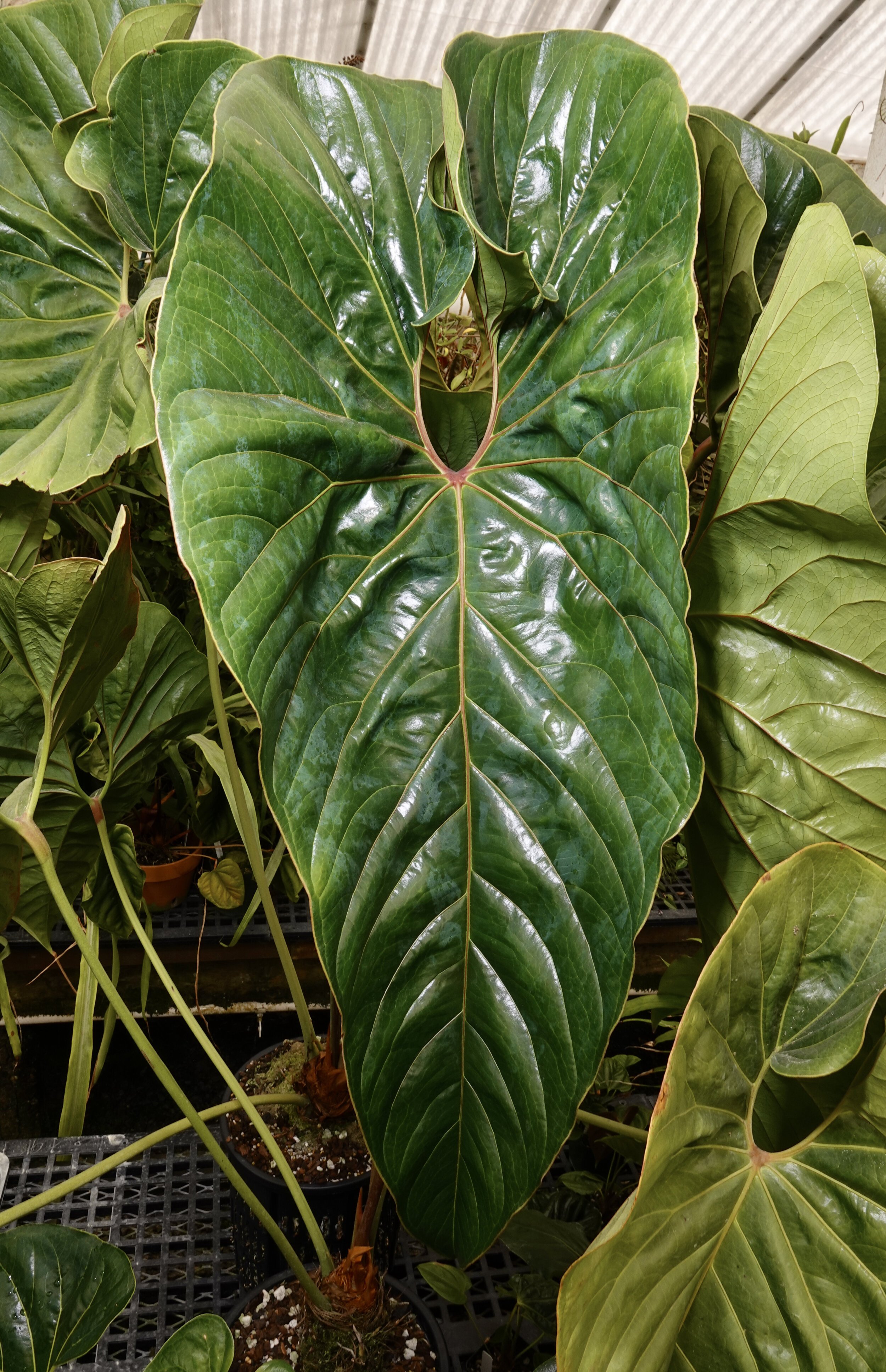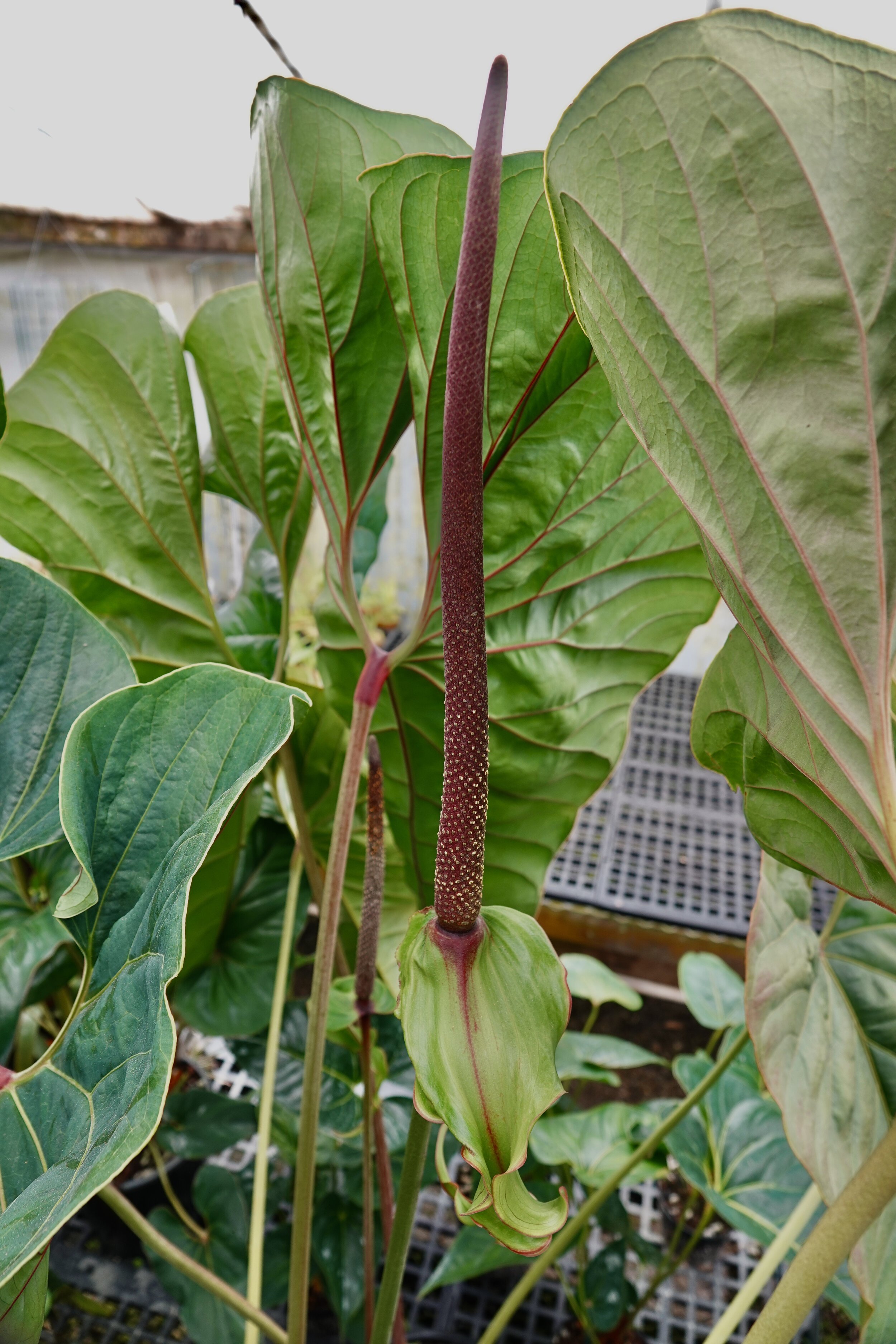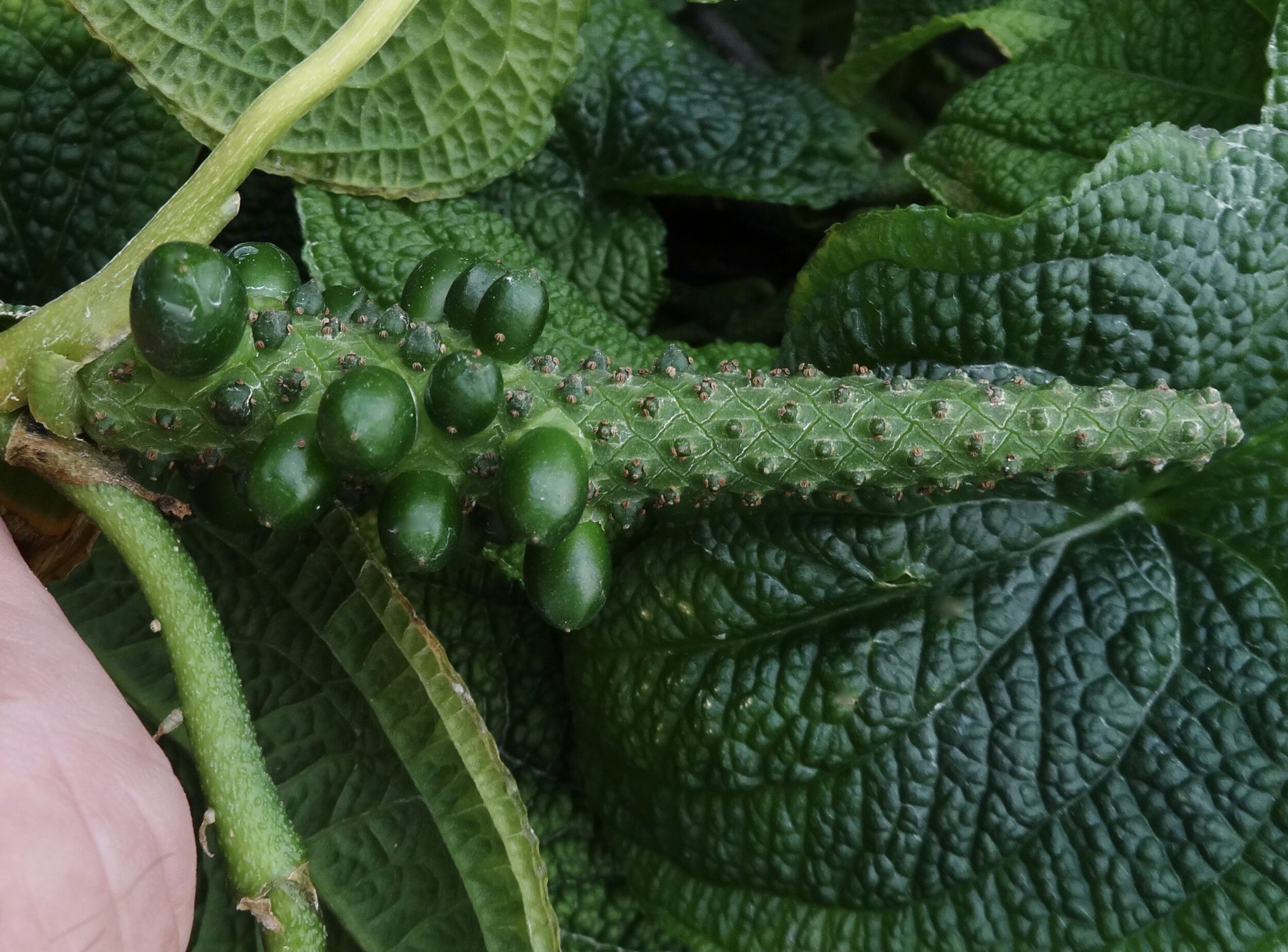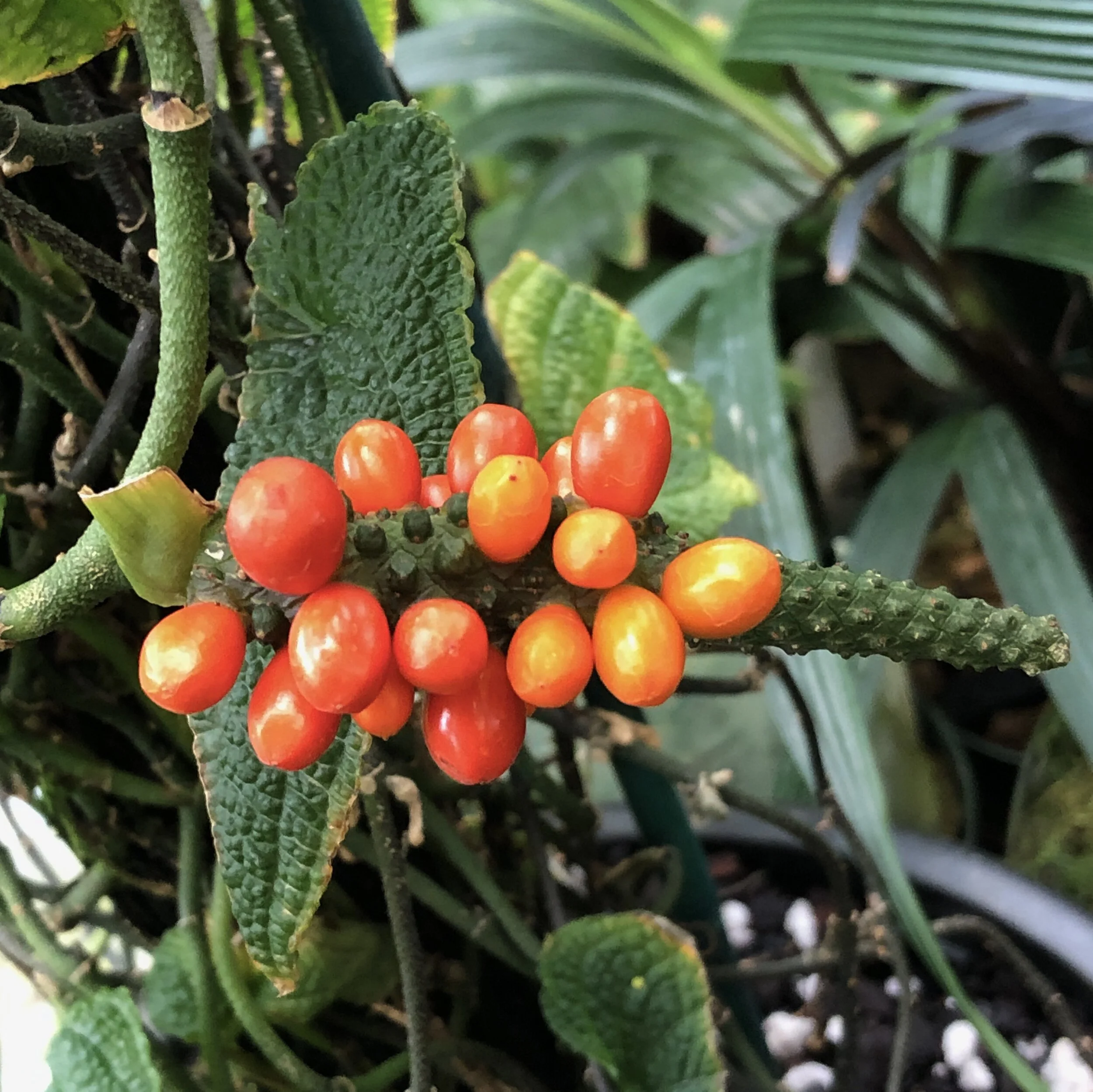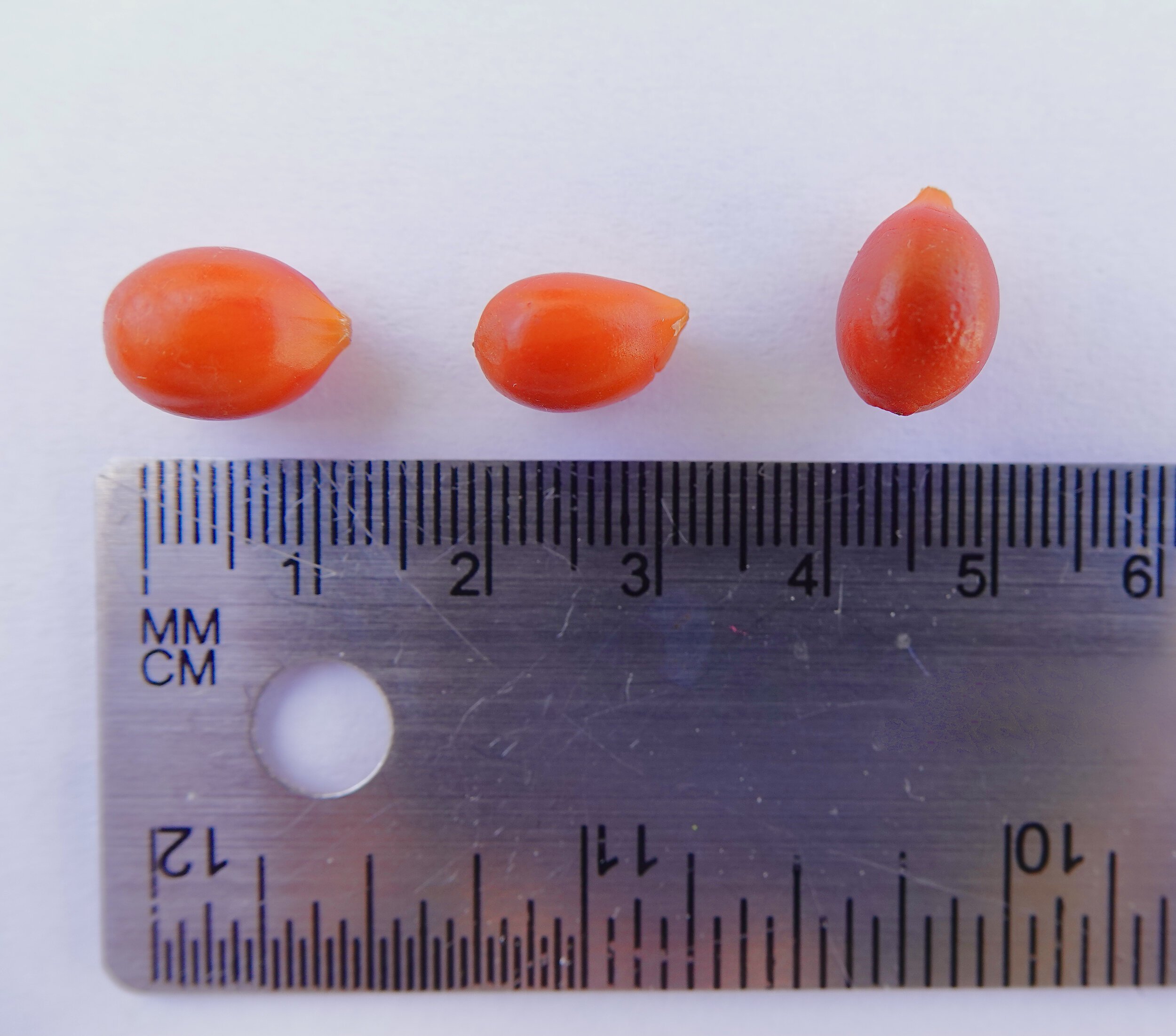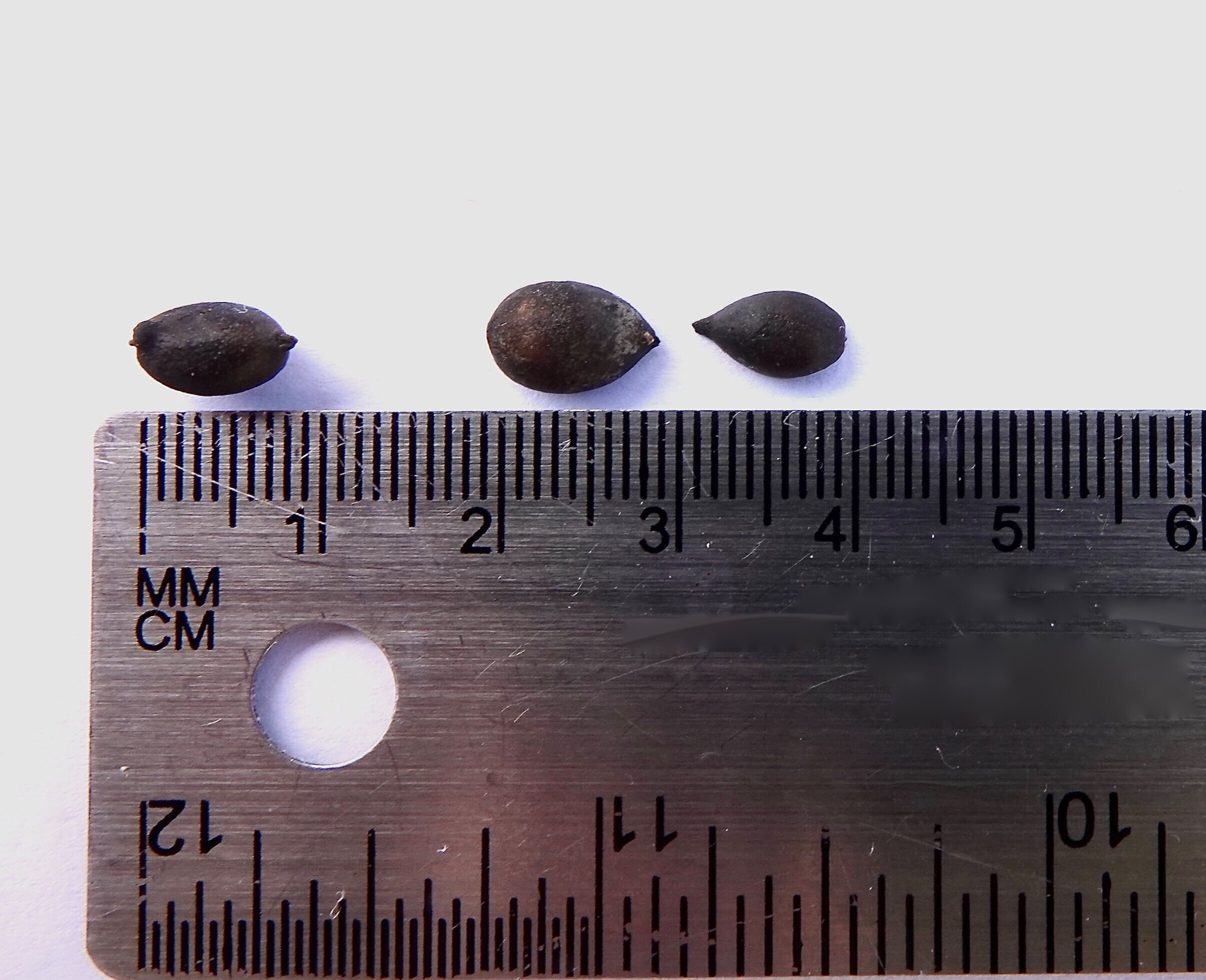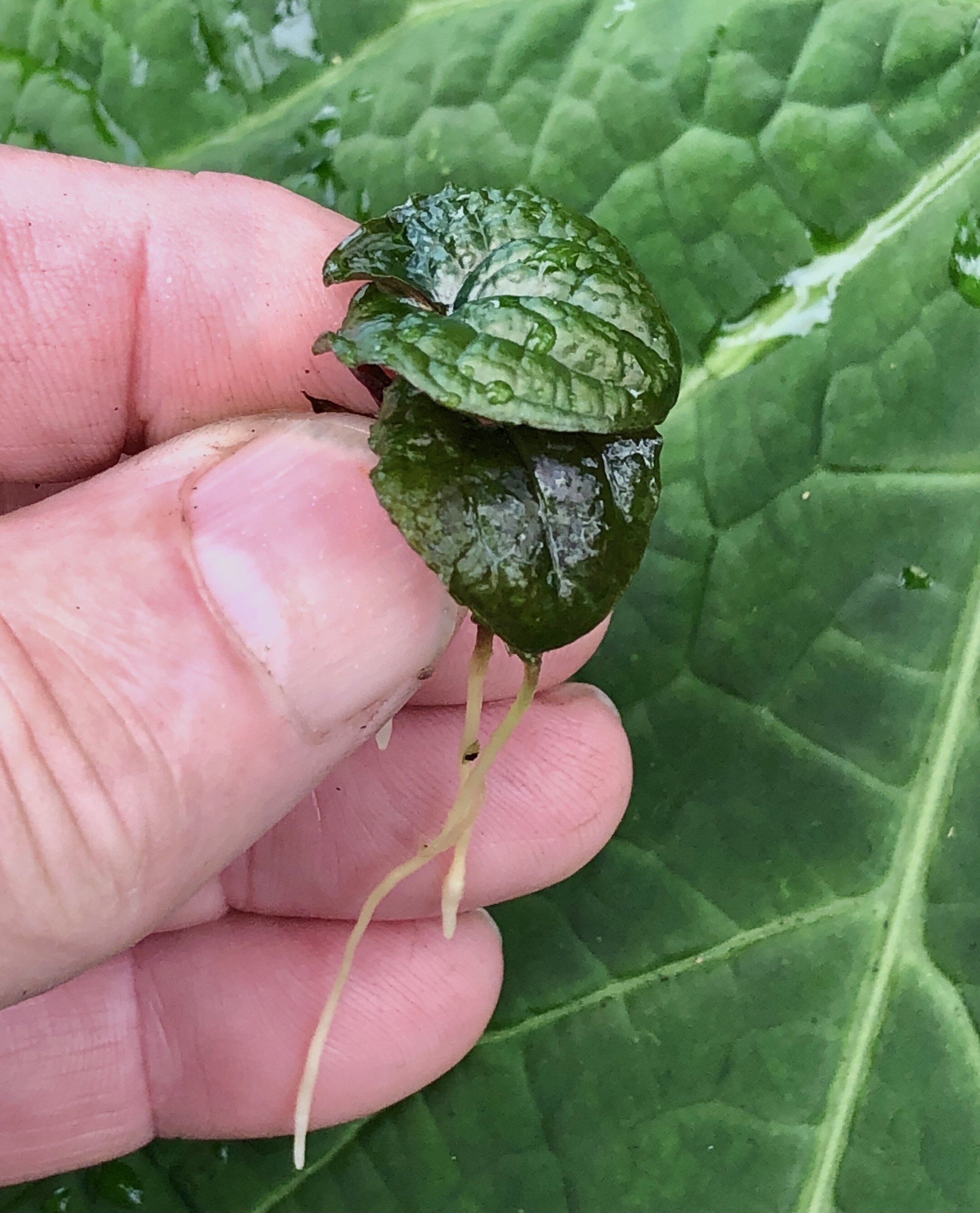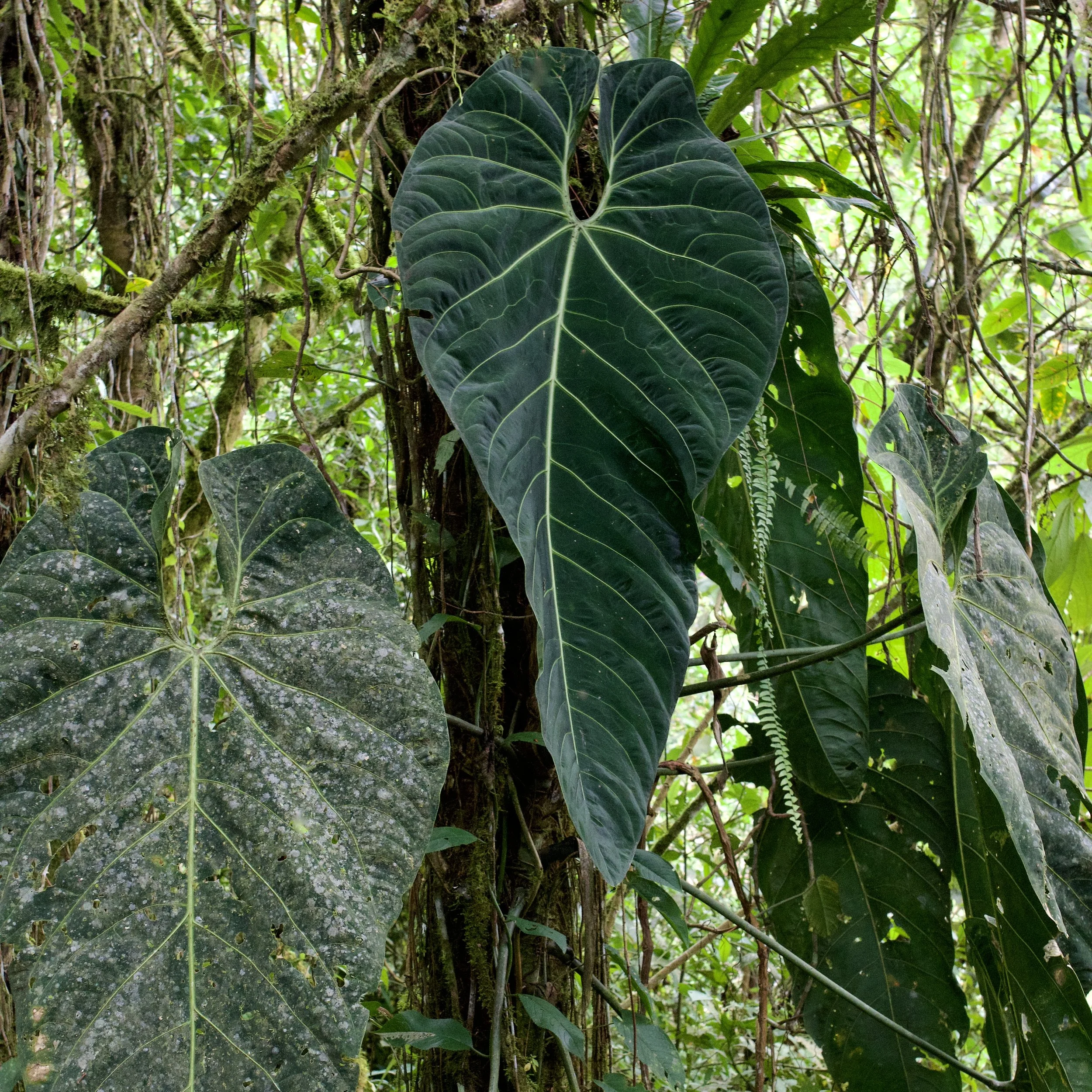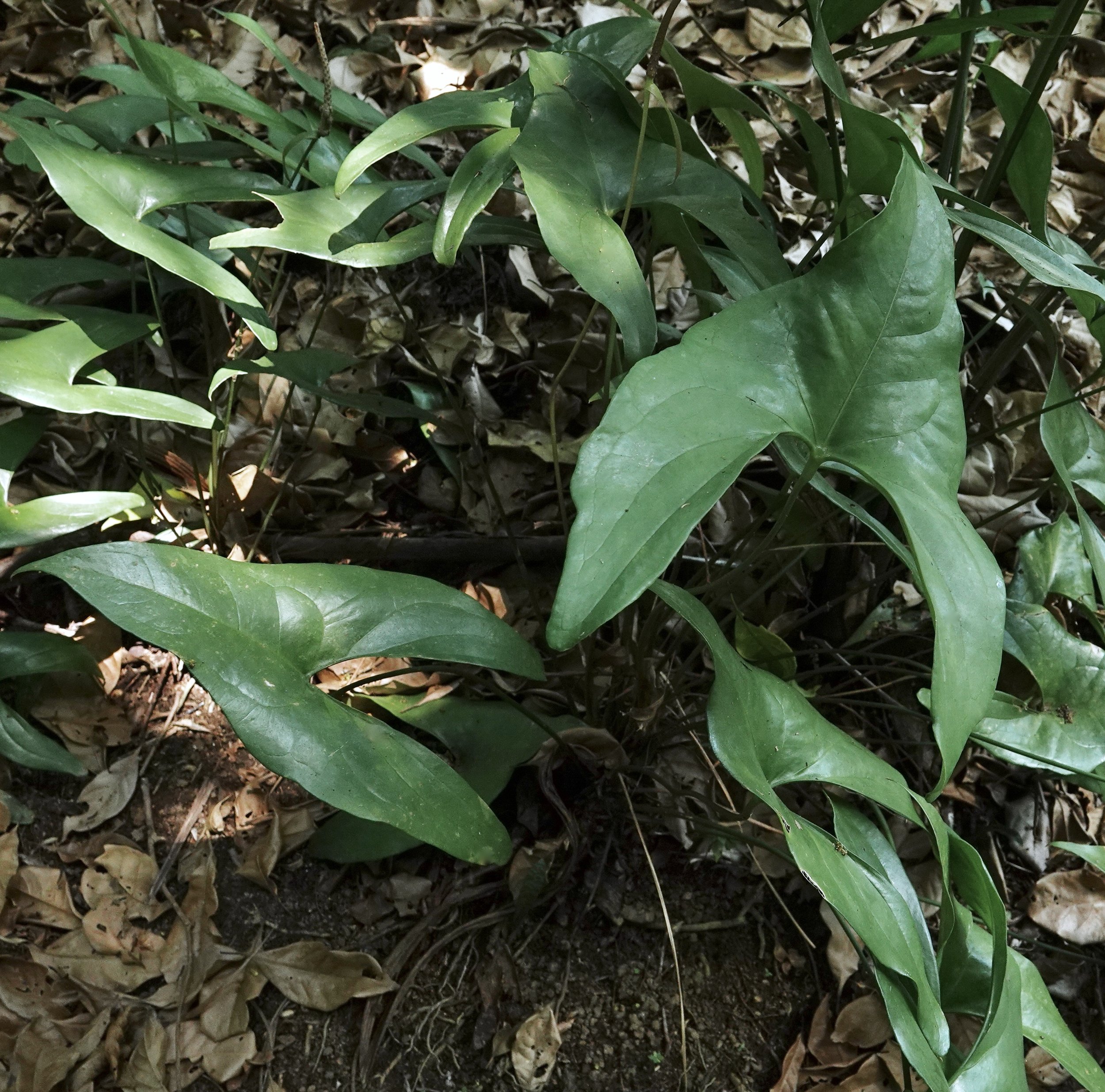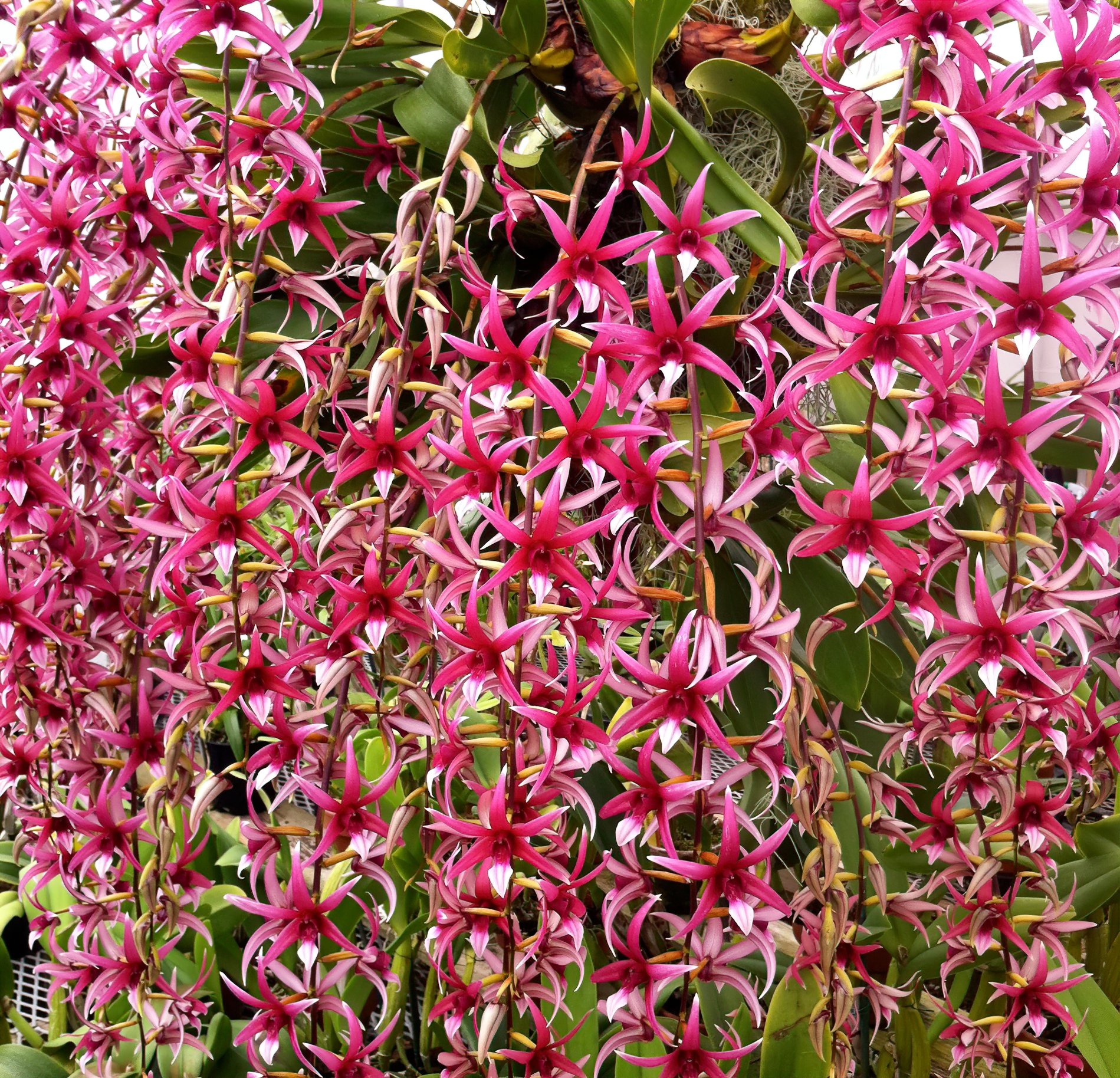Raising a Little Stink
Notes on Anthurium clidemioides, A. pacificum, and A. flexile in nature and cultivation
by Jay Vannini
Many small species of tropical rainforest aroids with decorative leaves are popular subjects for plant collectors and herpetoculturists with terraria, vivaria or custom-built plant cases in their homes. The climbing forms are especially desirable for this niche because the plants are often fairly slow growing, look suitably “exotic”, and can fully exploit both horizontal and vertical planes within these enclosures.
Despite its relative rarity in cultivation, one of the most sought-after of these terrarium-friendly aroid species is the remarkable-looking southern Central American native, Anthurium clidemioides.
Paul Carpenter Standley at the Field Museum, ca. 1940.
Anthurium clidemioides was described in 1940 by U.S. botanist Paul C. Standley (d. 1963) based on a collection made in 1938 at 2,600’/800 masl in Villa Quesada, Alajuela Province, Costa Rica by Manuel Valerio (listed as Valerio collection number 1726). Then a curator at the Field Museum in Chicago, Standley had accumulated extensive experience as a taxonomist while collecting and cataloging the floras of remote regions of México, Central America and Panamá. He was the undisputed authority on Mesoamerican plants during much of his lifetime and, despite a complete lack of awareness as to the true dimension of Mesoamerican aroid diversity during the period when he was active as a botanist, Standley clearly knew the regional Araceae well (Williams, 1963; Popenoe, 1964; Croat, 1998). In the description he wrote: “This is one of the most distinct and remarkable of all the many species of Anthurium known from Central America, and I have seen no similar plant from any other region.” (Standley, 1940).
High praise indeed from a man who described or coauthored more than 6,200 new plant species, had four plant genera along with 16 species named after him, and who reportedly could identify thousands of living Neotropical plant species at a glance (Williams, 1963; Tropicos and Wikispecies online author reference search, as of July 2021).
Clidemia (Miconia) pubescens in tropical rainforest understory, Caribbean lowlands, Costa Rica. Anthurium clidemioides occurs in sympatry with this attractive melastome at all of its known Costa Rican lowland localities ©F. Muller 2021.
The specific epithet derives from clidemia + oide = “clidemia-like”, in reference to the resemblance its leaves have to those of the the soapbush (Clidemia hirta) and many of its cogeners. The soapbush is a shrubby melastome that ranges throughout the wet Neotropics that is now considered a highly invasive weed in many tropical regions across the world. Nonetheless, several species in its genus are valued as ornamentals by collectors in northern countries.
Anthurium clidemioides was segregated into two subspecies by Thomas Croat and Michael Grayum, largely based on additional collections made at low elevations at Alto de Carbonera in Puntarenas Province, Costa Rica in 1990 (listed as Chacón collection number 1062 in Grayum, 1997). It was elevated to full species status by Thomas Croat and myself in 2022 (Vannini, et al. 2022).
It is placed in Anthurium section Polyphyllium Engler, which currently includes only six recognized species: A. algentryi Croat, A. scabridulum Croat, A. clidemioides Standley, A. flexile Schott, A. muelleri J. F. MacBride, and A. pacificum (Croat & Grayum) Vannini & Croat (Croat et al., 2010; Vannini et al., 2022; Croat et al., ms. in prep.). The latter four Mesoamerican taxa together range from eastern México southwards to eastern Panamá from sea level to ~5,200’/1,600 masl. The other two species (A. algentryi and A. scabridulum [edit - now doubtful]) are restricted to the Chocó Department of Colombia; one at low elevations and the other in high elevation cloud forest at ~8,100’/2,500 masl (Croat, 2010). The best-known plants of this group, A. clidemioides and A. flexile, are mostly associated with lowland tropical rainforests with the latter species ranging from Veracruz and Chiapas states in México to the Darién Province in Panamá. This section is unique in the genus for lacking one-ribbed cataphylls (rudimentary scale leaves that precede true leaf emergence) and all developing long, wiry, root-studded climbing stems. New leaves emerge directly from terminal shoots of sympodial growths that, in turn, often branch from the leaf axils of active stems that lead to superposed, pleionanthic shoots or a distinctive “dendritic” growth habit. This remarkable type of stem morphology is known from only one other aroid group, Pothos subgenus Allopothos. Adventitious roots emerge along the length of the internodes with clustering often evident at the bases of leaves.
Long considered a “natural grouping”, a molecular phylogeny for Anthurium supports the conclusion that section Polyphyllium is the earliest divergent lineage for the genus and includes some of its most specialized known forms (Croat & Baker, 1978; Carlsen & Croat, 2013; Carlsen & Croat, 2019; Carlsen-Krause, pers. comm.). Divergence from other Anthurium species occurred 10-11 million years ago in the Late Miocene, a period that overlaps with major uplift of the Central American land mass and its subsequent effects on speciation, distribution and patterns of endemism in Neotropical flora and fauna (Wallace, 1997; Carlsen & Croat, 2013). Bliss and Suzuki (2012) and Carlsen and Croat (2013) conducted molecular analysis of both Anthurium clidemioides and A. flexile including nuclear genome sizes and other DNA work in these studies. Their preliminary findings are that early polyploidy occurred in A. flexile, which has 2X the chromosome numbers of A. clidemioides (with 2N = 30), despite both species having approximately the same genome weights (Bliss & Suzuki, 2012). Hybridization is proposed as one possible speciation route in A. clidemioides, an evolutive process that appears ongoing at one site in western Panamá (see below). However, what seem to be derived morphological characters (e.g., pedunculate inflorescences, stipitate spadices, larger leaves, etc.) in most other species in section Polyphyllium suggests to me that A. clidemioides may be one ancestral form in this group. Aspects of its reproductive biology also exhibit unique traits, especially its carrion scent emission at anthesis (pers. obs., reported here and still unreported in other members of section Polyphyllium), and hard-coated black seeds; one adaptation shared with all of its close relatives.
As was mentioned above, previous taxonomic treatments of Anthurium clidemioides included two subspecies readily differentiated from one another by conspicuous morphological characters when mature. What was formerly considered the nominate form (subsp. clidemioides) occurs in coastal and foothill tropical rainforest of the Caribbean versant from northern Costa Rica to western Panamá from near sea level to ~2,600’/800 masl. More specifically, A. clidemioides has been collected from areas proximate to the Nicaraguan border region of northern Limón and Heredia Provinces (W. Stevens collection number 24526) discontinuously through to southern Limón Province near Sixaola, Costa Rica (Edgar Mora collection, InBIO), and again as an apparently disjunct population in the forested lowlands of Bocas del Toro Province of Panamá. Due to large blocks of well-protected contiguous forest present across the Costa Rican-Nicaraguan border in the eastern portion of the Río San Juan Biosphere, A. clidemioides almost certainly occurs in southeastern Nicaragua in the Indio Maíz Biological Reserve. According to Holdridge Life Zone maps for Costa Rica, it occurs in Tropical Wet Forest, Tropical Moist Forest and Premontane Wet Forest (Janzen et al., 1983) and so north into Nicaragua and south into Panamá.
Above left, a very full example of the “old” clone of Anthurium clidemioides now grown by aroid collectors around the world and shown in my personal collection in California. Despite the similarity of its leaves to plants found in the Caribbean foothills of northeastern Costa Rica, its origin remains unknown although likely ex-Finca La Selva in Puerto Viejo de Saripiquí. Right, a mature leaf on an A. clidemioides accession from the foothills west of Puerto Limón, Limón Province, Costa Rica that is also part of my personal collection. Both of these individuals can grow almost entirely black leaves when cultivated under light conditions below 250 fc/2,690 lux. Author’s plants and images.
This species has a remarkably spotty distribution across its range and is not reported as being particularly common anywhere. As recently as 1978, Anthurium clidemioides was known from only five preserved collections, including the holotype and one made from a cultivated plant at the Roberto Burle Marx Garden near Rio de Janeiro, Brazil (Daniels & Reed collection number 3619 in Croat & Baker, 1978). Much of the Caribbean lowlands of Costa Rica and Bocas del Toro Province in Panamá are very well botanized, so it is unlikely that the significant gaps between documented populations of A. clidemioides across well-preserved mature forested areas of both countries are an artifice of collection.
Despite its popularity in cultivation among specialty aroid collectors this is, seemingly, a rare plant in nature.
Anthurium pacificum (Croat & Grayum) Vannini & Croat, until recently treated as A. clidemioides subsp. pacificum, is reported on both versants of Costa Rica from central Alajuela, northwestern San José and southern Puntarenas Provinces on the Pacific versant discontinuously onto the Caribbean slope of western Panamá to ~2,000’/600 masl. As is the case in A. clidemioides, known populations are mostly localized and disjunct, often separated by considerable distances. Anthurium pacificum is characterized by much larger overall height (to at least 33’/10 m tall), deltoid to ovoid mature leaves to 13”/27 cm in nature and at least 11”/23 cm in cultivation (Grayum, 1997; D. Hannon, pers. comm.) compared to 4.5”/11 cm leaf blades in mature A. clidemioides. It also has truncate, shallow and V-shaped leaf sinuses or subcordate leaf bases in all Panamanian material, but also cordate (occasionally with overlapping basal lobes) leaf bases in some large Costa Rican Pacific lowland origin plants. Its leaf surfaces are noticeably less bullate than A. clidemioides and also exhibit a very distinctive subvelvety or glittering, satin-like aspect. Flowering A. pacificum are easily differentiated from A. clidemioides by their very short peduncles to >0.75”/2 cm and violet-colored spadices as compared to sessile axillary inflorescences and green spadices in A. clidemioides (see images below).
Leaf detail on a cutting grown Anthurium pacificum collected by U.S. botanists on the Osa Peninsula, Puntarenas Province, Costa Rica and cultivated in the author’s collection in California. Even as a young plant, the longest leaves shown here are already over 7”/19 cm long. Fungicidal spray residue masks satin-velute upper leaf surfaces. Author’s image.
Stem texture also differs between these species, with those of Anthurium clidemioides having very warty/verrucose, densely irregular-tuberculate surfaces, while in A. pacificum these tubercles are more sparsely distributed with the raised processes along the stem being mostly elongated in shape.
An apparently isolated population of Anthurium clidemioides occurs near sea level at a locality on the Caribbean versant of western Panamá. It is separated by approximately 65 miles/100 km airline from the closest known Costa Rica Caribbean lowland population in Limón Province. In 2018, together with two companions, I came across this poorly sampled population located in northern Bocas del Toro Province, Panamá. As one ascends in elevation at this site it appears to cross with A. pacificum higher in the foothills (see below) beginning at approximately 900’/270 masl and very likely ranging much higher at this largely intact forested locality with very restricted access. These plants appear to represent an intermediate form between the two recognized taxa, so are possibly a natural hybrid or part of a hybrid swarm. In 1985, Thomas Croat and Michael Grayum collected sterile material later identified as A. pacificum between Fortuna and Chiriquí Grande ca. 12 miles/19 km airline distant from this site at an elevation of 1,900’/590 masl. This specimen (Croat collection number 60202) strongly resembles the intermediate form shown in images below. Plants observed and photographed near sea level at this locality show typical A. clidemioides characters including densely tuberculate stems, slightly overlapping basal lobes on suborbicular leaves, smaller leaf sizes overall and very dark leaves in plants observed growing in deep shade. In the foothill plants, the leaves suddenly change size (much larger; to >8”/20 cm), general aspect and color. Upper leaf surfaces are subvelvety, as shown. Stem texture is also intermediate between the A. clidemioides and A. pacificum. As is similar to the case for A. clidemioides growing at lower elevations there, this population is also separated from Pacific versant Costa Rican populations of A. pacificum on the Osa Peninsula by a hiatus of ~90 miles/145 km airline.
Above, plant habit and leaf detail of a putative natural hybrid of Anthurium clidemioides and A. pacificum shown in nature in Bocas del Toro Province, Panamá. Note the considerable variation in leaf size and shape–from narrow deltoid to ovate cordate–a characteristic of all plants I observed in this population. Author’s images.
Some plants from the northern end of the range have more open leaf sinuses than plants from further south and inland in Limón Province, Costa Rica. A collection made by botanist Gerardo Herrera in 1995 (Herrera collection number 7807) at near sea level in Tortuguero National Park on the Caribbean slope of northern Costa Rica also combines several morphological characters of both species (Grayum, 1997), including large leaf size with subcordate leaf bases and a green spadix. Images of live plants taken in 2019, also in Tortuguero NP and published on iNaturalist show individuals with elongate, deltoid leaves and subcordate leaf bases. This ecotype appears morphologically distinct from plants collected at higher elevations in the foothills further west at localities such as La Selva Biological Station at Puerto Viejo de Sarapiquí. The possibility that coastal populations of A. clidemioides on the Costa Rica-Nicaragua and Costa Rica-Panamá border regions are more closely related to each other than to inland populations in northern Costa Rica is a very real possibility given possible long-distance avian and/or chiropteran seed dispersal of this species along the Caribbean lowlands where it occurs.
As alluded to earlier, Anthurium clidemioides and A. pacificum superficially resemble several Clidemia (Melastomataceae), Piper (Piperaceae) and Pilea (Urticaceae) species with heavily bullate leaves that occur sympatrically throughout the region (Standley, 1940; Croat, 1983). Because of their very attractive if rather unconventional aspect for a scandent aroid, both A. clidemioides and A. pacificum have caught the eye of many visiting plant collectors and naturalists. They have been photographed in habitat by botanists at a number of Costa Rican protected areas, especially at the La Selva Biological Station in Heredia Province, Tortuguero NP in Limón Province, and at Corcovado NP as well as other reserves on the Osa Peninsula of Puntarenas Province. Some of these images are posted online by the Organization of Tropical Studies/OTS site, the “Flórula Digital de la Estación Biológica de La Selva” together with that of French horticulturalist Patric Blanc’s Vertical Garden website.
Photos shown on the internet of this species in nature invariably depict a short statured, understory hemiepiphyte dangling from lower limbs or adpressed to tree trunks of modest diameter. At two tropical rainforest localities subject to high precipitation in eastern Costa Rica and western Panamá the author observed this species growing both as a terrestrial plant–forming an almost jet black, heavily textured creeping groundcover occupying small patches of shady forest floor–as well as a sparse vine climbing as much as 13’/four meters into the lower canopy of trees in lightly disturbed primary forests.
Besides growing as a fairly tall hemiepiphyte, Anthurium pacificum has also been found growing as a creeping terrestrial in open areas on slopes in southeastern Costa Rica (Grayum, 1997; D. Hannon, pers. comm.).
Anthurium flexile is a wide ranging, often confusingly variable hemiepiphyte or epiphyte that is relatively abundant at some Caribbean and Gulf coast lowland localities in southeastern México and northern Central America. Distributed from central Veracruz state, México to eastern Panamá, it is generally associated with very shady, warm and wet ecosystems mostly below 1,300’/400 masl. It occurs in sympatry with A. clidemioides in at least two lowland localities in northern Costa Rica and also in Bocas del Toro Province in Panamá. Some exceptional forms with cordate leaf bases are reminiscent of A. pacificum and can also have fairly large leaves to 8”/20 cm. Spadix color varies across its range, varying from yellowish green to plum colored, with dark spadices present in plants at both extremes of its range. Berries ripen bright orange and are conspicuously displayed in mid air to attract dispersal agents (bats?) on long pedunculate infructescences.
A cultivated Anthurium flexile from the Caribbean coast of Guatemala in the author’s collection in California. Leaf shape in this species is highyl variable. Author’s image.
Anthurium muelleri was described as a species by James Macbride in 1934, considered a subspecies of A. flexile by Croat and Baker (1978) and again in Croat (1983), now being re-elevated to full species status (Croat et al., in prep.). This is an upland species ranging from Oaxaca to western Guatemala on the Pacific versant that is largely distinguished by its narrow lanceolate leaves, minor details of leaf venation and a stipitate spadix. Spathe and spadix green with fruit ripening bright red. Gulf coast plants from Veracruz, México currently assigned to this species in global herbaria almost certainly represent A. flexile. Cloud forest populations of A. cf. flexile from >3,250’/1,000 m in central Nicaragua, much like northwestern-occurring A. muelleri, deserve scrutiny to determine their relationships with plants from lowland populations on the Caribbean versant in this region and determination as to their taxonomic status.
I am familiar with Anthurium clidemioides, A. pacificum, A. flexile, and A. muelleri in nature at a number of localities throughout their ranges in Mesoamerica. I have also grown two of these species in my collections in Guatemala and California on a continuous basis for over two decades, and the third (A. pacificum) from a Huntington BG division since early 2020.
Cultivation
All species from section Polyphyllium currently in cultivation require high humidity, uniform warmth and subdued lighting in order to thrive. They originate from areas of high precipitation (~98-176”/2,500-4,500 mm annually). Although many grow them staked, in my experience they do best when backed with a tall tree fern fiber totem. Free draining substrates are a must. Cuttings grow well for a while in sphagnum moss but will decline if kept in this growing media for prolonged spells. Although A. clidemioides is somewhat slow in cultivation, well established Anthurium flexile can be very fast-growing and almost invasive in greenhouses when mature specimens are grown under optimum conditions.
It is gospel among old school aroid growers that Anthurium clidemioides perform best when supplemental calcium sulfate or calcium nitrate are fed on a frequent cycle. Based on admittedly unscientific observation with my own plants, this certainly seems to be true. It would be interesting to examine the soil chemistry at known A. clidemioides localities and determine whether there is indeed any correlation between surface marine limestone evident in some regions where this species occurs (e.g., coastal Bocas del Toro Province, Panamá) and adjacent areas where it is absent. Together with the range of its so far unknown pollinator/s and dispersal agents, soil type may end up being a limiting factor in its distribution in nature.
Leaf detail on an 18 month-old, seed-grown F1 Anthurium clidemioides cultivated by the author in California. These selfed seedlings are very striking in appearance and are among the most attractive individuals of this species I have seen. Author’s image.
Anthurium clidemioides is well known for its relatively prompt response to major fluctuations in light intensity, with changes in both new leaf size and existing leaf color occurring when light levels are lowered. These variations can be triggered on plants from different origins as well as on the same plant repetitively over time, indicating that it is a “hard-wired” evolutionary adaptation to sudden changes in its environment; most likely in response to periodic arborescent canopy loss that produce light gaps in rainforest and corresponding higher sunlight intensity along the forest floor. Low light conditions produce larger leaves in mature plants with an almost genuine black color. These are intensely bullate when grown dark but will then change to more compact, greener leaves when exposed to higher light intensities (i.e., >300 fc/3,230 lux).
Like most vining-type hemiepiphytic aroids, if grown without support, all the species being discussed here will tend to “run” horizontally towards deeper shade (skototropism) and develop long internodes with very small or no leaves along the way. Once erect against a shaded vertical surface, they regain short internodal spaces and almost immediately develop normal looking leaves.
Despite its relative popularity among tropical aroid growers, very few provenanced wild accessions of any species in section Polyphyllium appear to have made their way to cultivation. Based on recent conversations with Dylan Hannon of the Huntington Botanical Garden in California, it seems likely that there were, until very recently, more well-documented examples of Anthurium pacificum in cultivation than of A. clidemioides or A. flexile. Two A. clidemioides accessions circulating in the U.S. are said to have originated from well-known aroider Neil Carroll ex-hort. Panamá (Croat 79567) and from the Atlanta Botanical Garden, respectively. There is at least one wild origin A. flexile clone in U.S. horticulture known from an accession made in lowland Veracruz, México (fide L. Hannon, d. 2006), together with replicates of my F1 seed grown plant propagated from material collected at a Caribbean coastal locality in Izabal Department, Guatemala.
It appears that most Anthurium clidemioides in cultivation descend via stem propagations from a single, somewhat maladapted individual of uncertain original provenance (although likely a research station in NE Costa Rica - see comments above) that is very challenging for most growers to succeed with, much less reproduce from seed. Because of this, many collectors opt to cultivate their A. clidemioides specimens in misted terraria rather than under or on an open greenhouse bench. Recent accessions of both Costa Rican and Panamanian-source A. clidemioides and A. cf. clidemioides from newly-discovered lowland sites have proven more vigorous in captivity and are–most definitely–easier to propagate from stem cuttings than the older material circulating in the trade.
However: In mid 2018 a large plant of that same “difficult” clone that I have been growing since early 2000 and obtained from Florida aroid collector Ralph Lynam (d. 2010) began flowering in my California collection. On my first attempt at breeding it, as a seed parent the plant was crossed with a much larger, very distantly related Anthurium species in an intersectional hybrid attempt made in May 2018. After carrying a normally developing infructescence for five months, a careless visitor accidentally snapped it off while manipulating the plant without authorization.
Above left, a developing inflorescence on an Anthurium clidemioides in the author’s collection in spring 2018. Right, developing infructescence shown 120 days later prior to being lost a month afterwards in an “accident” caused by a guest.
This is one very good example of why you should sic a grouchy pet leopard on any sticky-fingered busybodies who feel compelled to manhandle wild plants and animals being used in reproductive experiments.
That advice aside, a subsequent examination of the broken infructescence under low magnification showed in cross sections that many of the large, immature berries revealed developing embryos and normal green seed morphology. There is no doubt in my mind that this species can be used as a maternal parent plant in at least some cross-sectional hybrids and is a much better candidate for production of showy, creeping, intensely pebbled leaf hybrids than the proven Anthurium radicans from Espírito Santo State, Brazil. As part of an early divergent lineage, the ability of Anthurium clidemioides to hybridize with species that are widely variant in aspect and origin, presumably sets the stage for the entire genus’ ability to hybridize across very disparate sections (pers. obs.).
In late April 2019 this clone was successfully self-pollinated using fresh pollen harvested from an earlier inflorescence that was still in good condition on the plant. Development of the infructescence was then monitored and photographed on a regular basis. Ripening time to full maturity was 270-275 days from hand pollination. Germination from dilute bleach sterilized seed began at 15 days. Seedling leaves are essentially a smaller version of mature foliage. As is the case in many delicate Anthurium species, seedling mortality following full germination was very high despite careful cultivation throughout early growth. By 18 months of age, surviving plants began growing at an accelerated rate and had achieved new leaf sizes of 3”/7.5 cm.
Anthurium clidemioides lacks a visible peduncle (other species in the section have pedunculate inflorescences to lesser or greater degrees) and the inflorescence emerges at the junction of stem and leaf axil with the spadix initially hidden by a clasping spathe (see images above).
Its flowers are distinctly malodorous both at and post-anthesis when environmental conditions favor scent dispersal (i.e., very warm and humid). The smell is carrion-like, strongly reminiscent of decomposing rodent and–at its peak–is readily detectable downwind from greenhouse fans for at least 12’/4 m away. This particular scent type, perhaps the product of methyl-sulfide volatiles, appears unique in the genus which, while having other species with unpleasantly scented flowers, is not known to have any others that emit carrion-like odors (Schwerdtfeger et al., 2002; Croat, pers. comm.; Maia, pers. comm.). This remarkable character was independently verified by greenhouse workers where my personal collection is housed in California. It was first noted on a herbarium sheet (with color photos of a flowering live plant as part of the accession) by Missouri Botanical Garden Curator of Central American botanical research, Warren D. Stevens on an Anthurium clidemioides collection made at 260’/80 masl together with Olga Montiel at Cerro Coronel in Limón Province, Costa Rica (Stevens 24526) in 1986 as: “…spadix green in fl., with a strong foul odor…”. This impeccably sourced field observation has apparently been overlooked by others until now.
Nota Bene: Cerro Coronel is located within the Barra Colorado Wildlife Refuge and is within 5 miles (8 km) of the Costa Rican border with Nicaragua, again evidencing the strong likelihood that Anthurium clidemioides ranges well into a large and well-protected national reserve in southeastern Nicaragua.
In correspondence, Mónica Carlsen-Krause, a researcher at the Missouri Botanical Garden referenced USDA-ARS researcher John Suzuki in Hilo, Hawaii as having flowered this species several years ago in a research collection there with pollen harvested; no observation made on scent (Carlsen-Krause, pers. comm.).
Anthurium clidemioides is also unique among species in the genus (or for plants in general for that matter) that have been studied so far in that the exserted anthers that persisted on successfully pollinated inflorescences of my plant continued to emit a faint but discernible (at very close range) carrion-like odor for almost two months. This phenomenon was observed in one case in 2018 (infructescence knocked off by visitor prior to fully ripening as mentioned previously) and again on several inflorescences in 2019. Spadices/infructescences are shown at different stages of development from both years in images above and below.
Despite the presence of blowflies (Calliphoridae) in the greenhouse that were attracted to adjacently located, simultaneously flowering and frightful smelling Malesian Bulbophyllum orchid species (= seriously spoiled shellfish - Yikes!), during the carrion scent phase of flowering in Anthurium clidemioides no native or exotic pollinators were observed attending the spadix. This observation suggests that it likely has a specific endemic insect genus or species that pollinates it in nature, probably a rather localized fly/flies. In a study on the evolution of plant-pollinator interactions in Araceae, Chartier et al. (2013) propose that flies and beetles are both “ancestral” pollinators of aroids. If proven to be so, this is an interesting finding given the likelihood that A. clidemioides and a few other members of the genus are pollinated by large flies deceived by carrion, faecal and decomposing fruit scents (see paragraph below).
Immediately following final burnout of the malodorous phase and well after initial staminate anthesis, the developing infructescences’ odor abruptly switched to a slightly “musty” or yeast-like smell and were immediately visited by swarms of ubiquitous vinegar flies (Drosophila melanogaster) for several days afterwards (pers. obs. with photograph).
Genuinely stinky inflorescences are extremely rare in Anthurium species (Croat, pers. comm.; pers. obs.). That said, Hay and Cedeño Fonseca (2019) noted that the inflorescences of wild Anthurium decipiens in Risaralda Department, Colombia, “…are foul-smelling (varying from a rotten cheesy fæcal smell to a horrible stench of bacterially fermenting plant matter reminiscent of long-liquified vegetables at the bottom of a neglected refrigerator!) although the smell does not carry far from the spadix…”. These spadices attracted several genera of flies at two different localities in western Colombia.
I have large flowering examples of seed grown, second-generation A. cf. decipiens in my collection in California that originated from the Franz Gruber garden in Fusagasugá, Cundinamarca Department in Colombia. I have monitored scent on them on a regular basis ever since reading the Hay and Cedeño Fonseca paper in Aroideana and have to admit that the sexy bits on all of my plants completely fail to impress. Far from being “foul smelling”, the spadix scent they emit here is quite innocuous in both phases of anthesis, and the dusty pollen has a very light odor of fermented fruit quite akin to that of cashew fruit cooking wine or cashew wine vinegar popular in Central America and Brazil. Unlike some other anthuriums I grow, the inflorescences do not attract any type of insect visitor in the greenhouse. Hay (2019) noted that a cultivated plant of Chocoan origin grown in his garden in Valle del Cauca Department is also very lightly scented and attracts euglossine bees, not flies. Oddly enough some male euglossines, despite being generally associated with orchids and other plants emitting pleasant-smelling floral fragrances, may also be attracted to high concentrations of indole, which smells vile (Hentrich, pers. comm.). All this is admittedly a bit “Inside Baseball”, but given these key differences in terms of scent and pollinator recruitment and what we know of anthurium pollinator coevolution, to me it seems worthwhile exploring the possibility that Chocoan and Risaraldan plants currently treated as A. decipiens–despite their many shared plant characters–represent different taxa.
*Edit: I also cultivate several young examples of Anthurium decipiens that originated from a seed collection made in the vicinity of the type locality. During the winter of 2021-2022 two of these plants flowered. Recent DNA analysis of their leaf tissue shows these plants have been shown to be distinctive entities (M. Carlsen, pers. comm.). Curiously, given what is known of plants occurring in nature, neither emitted any discernible scent either at pistillate nor staminate anthesis. It seems likely there is a key environmental factor missing in cultivation (edaphic?) that deprives captive plants of their ability to emit foul scents.
Above left, 42”/108 cm leaf on a young mature, underpotted Anthurium cf. decipiens flowering in the author’s collection in California. Some exceptional forms of this species can achieve leaf blade sizes in excess of 5’/1.55 m, and this decade-old plant is clearly well on its way there. Right, a recently pollinated inflorescence on a sibling plant grown alongside, showing dry pollen produced on the basal portion of the robust 18”/45 cm spadix. Author’s plants and images.
Berries ripen relatively slowly in Anthurium clidemioides (> nine months) and gradually change color from dark green to yellow, then to orange and (in some cases) bright red at final extrusion. In nature they are reportedly 5-9 x 4-6 mm, but this batch of artificially propagated material included several that were 15 mm x 10 mm. Seed number ranged from 1-2. Seed size is directly correlated to berry size and larger individual seeds in this batch measured 10 mm x 6-7 mm.
Above left, developing berries on Anthurium clidemioides in mid August 2019. Right, hard ripe berries on the same infructescence in late January 2020. Author’s plant and images.
Seeds of Anthurium clidemioides and A. flexile (and likely all other members of section Polyphyllium) are unique in the genus in having a glossy, dark brown or black, hard pericarp and strongly resemble the familiar seeds of apples (Malus domestica). Newly germinated Anthurium clidemioides seed is also unusual for plants in this genus in having a dark pink, as opposed to a white or green, radicle on emergence.
Very cautious sampling of the pulp of several hard ripe berries of Anthurium clidemioides by the author revealed no noticeable acridity and the taste, while rather bland, presumably sweetens a bit more when berries are fully extruded and soft.*
Above left, artificially propagated ripe berries of Anthurium clidemioides. Above right, clean seed of that batch immediately prior to sowing. Author’s images.
Above left, a six month-old seedling of Anthurium clidemioides prior to transplant following removal from a community pot. Mature leaf appearance evident in the eophyll (lower), is a character apparently unique in the genus. Author’s plant and image. Above right, same-sized but slightly etiolated Bocas del Toro Province, Panamá A. cf. clidemioides seedling with seed coat still attached and visible lower center at the juncture of stem and three roots. Despite the slight difference in leaf surface textures between these two plant types even at this early stage of development, this eophyll also exhibits mature leaf traits. The absence of heteroblasty in the leaf development of this species as it matures is very unusual in a climbing member of the Araceae, which are well-known for the extremes in appearances between their juvenile and mature “character” leaves. Image: ©Fred Muller 2021.
Presumably, when more information is available on the fruits of A. algentryi and A. scabridulum they will share these seed features. It is tempting to hypothesize–and seems very likely to me–that the hard seed coats are an adaptation to survive bat dispersal via passage over their molars and through their digestive tracts (endozoochory). Likely candidates include some of the frugivorous Phyllostomid/leaf nosed bat genera in the subfamily Stenodermatinae, such as the smaller species of Artibeus and Sturnira. Phyllostomids are known seed dispersal agents of a number of Philodendron and other aroid species in northern South America (Lobova & Mori, 2004; Lobova & Mori, 2005). Others are known to effect both local and long distance migrations on a seasonal basis (Fleming et al., 2020) and are likely important opportunistic epiphytic aroid seed dispersal agents throughout Mesoamerica as well.
*WARNING: Readers should NOT attempt to taste, ingest or force close skin contact of “wet” plant parts from any aroid not known with certainty to be edible or fairly innocuous, such as taro root (Colocasia esculenta), the fully ripe fruits of Swiss cheese/Mexican breadfruit (Monstera deliciosa) or mass market ornamental pot plants such as Anthurium x cultorum types. Severe discomfort, rashes, swelling and respiratory distress caused by acrid/toxic chemicals present in some Araceae may result from even fleeting oral or other sensitive skin area contact with their exposed green plant tissues. Don’t be reckless in testing the chemical defences of these plants against predation by playing citizen scientist on the internet.
You will very likely regret it if you do.
°
Acknowledgements
Paul Standley was a trailblazer in botanical explorations of Mesoamerica in the early and mid-20th century. His regional floras (published from ca. 1920 to 1952), while obviously dated at this point in time, remain invaluable reference works for contemporary botanists and naturalists working in the northern Neotropics. That he was a widely admired figure among his peers is clearly evident throughout, “A Homage to STANDLEY: Papers in Honor of Paul C. Standley” (Williams et al., 1963), a posthumously published collection of thoughtful tributes written by over two dozen U.S. and Latin American botanists who knew him well. It is our great good fortune that Anthurium clidemioides Standl., perhaps the most unique member of this immensely diverse aroid genus, was one of his most notable plant descriptions in a long and storied career.
I learned early on while exploring remote areas of Guatemala and Belize in the 1970s that anyone working with wild plants in nature throughout much of rural Central America and Panamá walks in his footsteps.
Standley died in the afternoon of June 2, 1963 in the Hospital Viera in Tegucigalpa, Honduras. He was buried in the cemetery of San Antonio de Oriente very near where he spent a very productive early retirement doing botanical research at the Escuela Agrícola Panamericana Zamorano from 1950 through 1956. The Paul Standley Herbarium there now houses 300,000+ curated specimens of Mesoamerican plants.
His scientific legacy continues to inspire.
Many thanks to Dr. Thomas Croat of the Missouri Botanical Garden who read a very early draft version this article and suggested publication. During our brief correspondence in 2018, Dr. Heiko Hentrich of the Universität Koblenz-Landau, Germany provided several excellent insights into complex anthurium scents and his work with euglossine bee pollinators. Thanks also to tropical plant scent specialist Dr. Artur Maia of the Universidade Federal de Pernambuco, Brazil for also sharing his thoughts on anthurium pollinators and scents, as well as his views on the major flaws of the human nose as an odor detection instrument. Dr. Mónica Carlsen-Krause, also with the Missouri Botanical Garden, took the time to read extracts of a late draft I sent her and carefully correct a couple errors of mine relating to divergent anthurium lineages, helped clarify key aspects in the timeline of the evolution of Anthurium section Polyphyllium, and suggested addition published sources of information on the early evolution of anthuriums. Dylan Hannon of the Huntington Botanical Garden provided his own valuable observations on wild populations of Anthurium pacificum on the Osa Peninsula in southeastern Costa Rica as well as in captivity, together with information on the origins of two older A. clidemioides accessions currently grown in the U.S.
The opinions and conclusions presented here are my own, and do not necessarily reflect the views of any of these correspondents.
Finally, many thanks to Fred Muller for providing the images of a Clidemia pubescens in nature in northeastern Costa Rica and the seedling Bocas del Toro Anthurium cf. clidemioides included above.
°
References Cited
Bliss, B.J and J. Y. Suzuki. 2012. Genome size in Anthurium evaluated in context of karyotypes and phenotypes. AoB PLANTS, Volume 2012: pls006. 15 pp.
Carlsen, M. M. and T. B. Croat. 2013. A molecular phylogeny of the species-rich Neotropical genus Anthurium (Araceae) based on combined chloroplast and nuclear DNA. Systematic Botany. Vol. 38, No. 3 (July-September 2013) pp. 576-588.
Carlsen, M. M. and T. B. Croat. 2019. An analysis of the sectional classification of Anthurium (Araceae): Comparing infrageneric groupings and their diagnostic morphology with a molecular pylogeny of the genus. Amm. Missorical Botanical Garden 104 (1): 69-82.
Chartier, M., M. Gibernau and S. Renner. 2013. The evolution of pollinator-plant interaction types in the Araceae. Vol. 68 (5): 1533-1543.
Croat, T. B. 1983 [1984]. A Revision of the Genus Anthurium (Araceae) of Mexico and Central America. Part I. Mexico and Central America. Annals of the Missouri Botanical Garden. Vol. 70, Number 2. 211-420.
Croat, T. B. 1998. History and Current Status of Systematic Research with Araceae. Aroideana, Vol. 21. 26-145.
Croat, T. N. and R. A. Baker. 1978. Studies in Araceae II: Anthurium section Polyphyllium. Selbyana 2: 230-238.
Croat, T. B., X. Delaney and C. V. Kostelac. 2010. New species of Araceae from Colombia. Willdenowia, 40 (1): 63-122.
Croat, T. B., M. H. Grayum, O. O. Ortíz, F. M. Cedeño, A. Acebey, J. P. Vannini, P. Díaz-Jiménez, M. A. Pérez-Farrera & M. Carlsen. [in prep.]. Checklist of the Araceae of Central America.
Fleming, T. H., L. M Dávalos and M. A. Mello (eds.) 2020. Phyllostomid Bats - A Unique Mammalian Radiation. University of Chicago Press. 512 pg.
Grayum, M. H. 1997. Nomenclatural and Taxonomic Notes on Costa Rican Araceae. Phytologia 82 (1): 30-32.
Hay, A. and M. Cedeño Fonseca. 2019. Anthurium decipiens, a gigantic new and apparently sapromyophilous species from western Colombia, with notes on the related and often confused Anthurium salgarense. Journal of the International Aroid Society. 42 (1):4-23.
Janzen, D. H. (ed.) 1983. Costa Rican Natural History. Chicago: University of Chicago Press. 823 pg.
Lobova, T. A. and S. A. Mori. 2004. Epizoochorous dispersal by bats in French Guiana. Journal of Tropical Ecology 20: 581-582.
Lobova, T. A. and S. A. Mori. 2005. Checklist of species dispersed by bats in central French Guiana. Bat/Plant Interactions in the Neotropics. New York Botanical Garden: https://www.nybg.org/botany/tlobova/mori/batsplants/batdispersal/batdispersal_frameset.htm
Popenoe, W. 1964. Paul C. Standley, An Appreciation. Ceiba, Vol. 10 (1) 4 pp.
Schwerdtfeger, M., G. Gerlach and R. Kaiser. 2002. Anthecology In The Neotropical Genus Anthurium (Araceae): A Preliminary Report. Selbyana 23 (2): 258-267.
Standley, Paul C. 1940. Studies of American plants. Field Museum of Natural History–Botany Vol. 22, No, 1. Publ. 463. Pp. 3-4.
Vannini, J., T. B. Croat and J. J. Castillo Mont. 2022. New species and a new combination of Anthurium (Araceae) from Central America. Aroideana 45, No. 2. 471-532.
Wallace, D. R. 1997. The Monkey’s Bridge: Mysteries of Evolution in Central America. Sierra Club Books. 277 pg.
Williams, L. O. ed. 1963. Homage to STANDLEY: Papers in Honor of Paul C. Standley. Chicago Natural History Museum Press. 115 pg.
All content ©Exotica Esoterica LLC® 2021-2025, ©Jay Vannini 2021 and ©Fred Muller 2021.
Follow us on:


